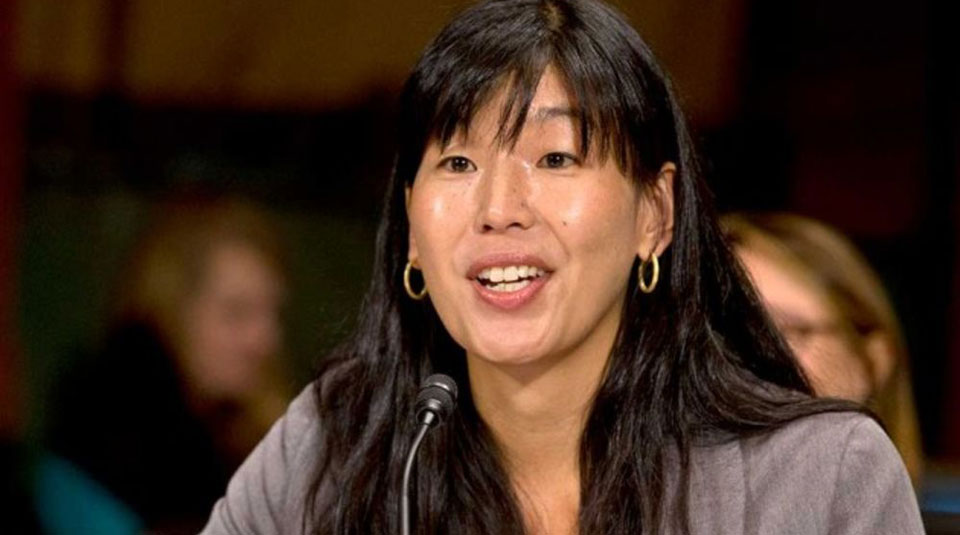
WASHINGTON—Advocates, from National Domestic Workers Alliance leader Ai-jen Poo to Megan Rapinoe, the outspoken leader of the U.S. Women’s National Soccer Team, used Equal Pay Day, March 24, to again push wide-ranging legislation against pay discrimination on the job.
Their testimony, before the House Oversight Committee, came as the Equal Pay Coalition, led by the National Women’s Law Center, reported the median 2020 income for a working woman nationwide was 82 cents for every dollar a median white man earned. That figure has barely budged in the last three decades.
That means, they said, the median working woman had to toil all of 2020 and through 2:40 pm EDT on March 24 to equal what the median white man earned in 2020 alone. For working women of color, the gaps were even worse and equal paydays later.
In only one state, Vermont, was the median wage gap below 10 cents, an NWLC chart showed. Working women in deep-red Wyoming were shorted the most, earning only 65 cents for every dollar the equivalent man earned.
Not mentioned: Unionized working women had a median weekly wage of $1,085 last year, the Bureau of Labor Statistics reported in January. That’s 87.2% of the $1,243 median weekly wage of union men, and 108% of the $1,003 median wage for all white male workers, the standard used for worker-to-worker comparisons.
That puts the median wage for union women—87.2 cents per union man’s dollar—behind the medians of only Vermont, Hawaii, and Maryland (89 cents) and California (88 cents). By contrast, Wyoming’s median figure was below that of the worst-paid group, non-union Latinas. BLS said their median pay last year was 68 cents per white man’s dollar.
Also not mentioned, even by Rapinoe, was women must go to court, and often are turned down, in demanding equal pay for equal work. That happened to the soccer team, though it dominates world soccer—unlike the awful U.S. men, who each earn at least double.
The wage gap initially rose after 1963 passage of the Equal Pay Act. Court rulings since hollowed out that measure’s impact, leading to advocacy of other measures. They include the Paycheck Fairness Act, to put teeth into the 1963 law, and paid family and medical leave.
Ai-Jen Poo, founder and executive director of the pro-union alliance, told lawmakers the pay gap for Latinas and other working women of color is even worse than calculations from BLS. She also said female domestic workers are shorted even worse than the rest if they can find jobs at all after mass business closures and people working from home due to the coronavirus pandemic. Those with jobs average $17,000 per worker yearly, she added.

“The pandemic deepened inequity for women who were already struggling,” Poo testified. “In March 2020, over 52% of domestic workers had no work. A week later, that number increased to 68%. On a call with our members, one woman held up her phone to the camera to show us she only had one cent left in her bank account. Like millions of domestic workers, she was faced with the impossible choice of keeping herself and her family safe and putting food on the table.
“As our child care centers and schools closed, our nursing homes became vectors” for the coronavirus pandemic “and all of us socially distanced, we realized” the U.S. as a nation “had no foundation or infrastructure to support our ability to care for our families, but for the invisible care work women did, and could no longer do in the same way.” And too many female “essential workers in minimum wage jobs—from restaurant workers to grocery workers—simply don’t earn enough to make ends meet or to make care work.
“Congress has a profound opportunity to rebuild and reset our economy to be more fundamentally more equitable. The only way to achieve fair pay for care workers is…to decide it’s a priority. As we look toward a jobs and recovery plan, we must invest in caregiving the way we invest in infrastructure. The care workforce and child care paid leave and home-and community-based care services will enable women and everyone else to return to work.”










